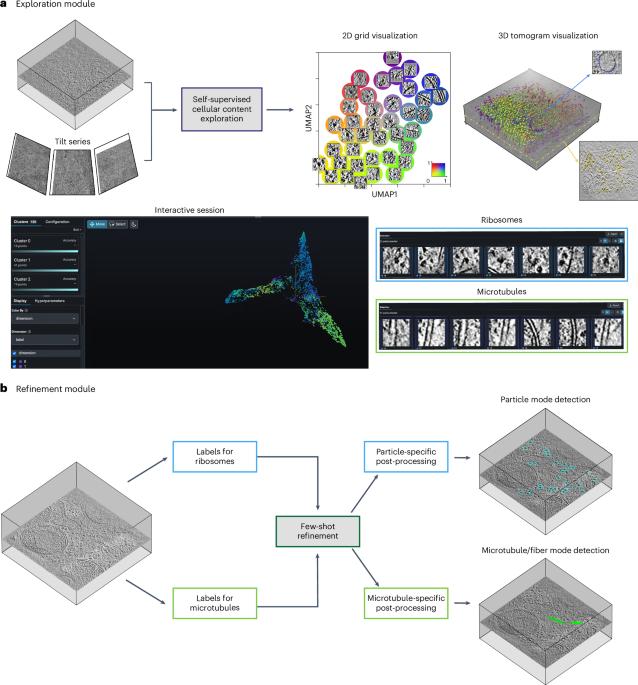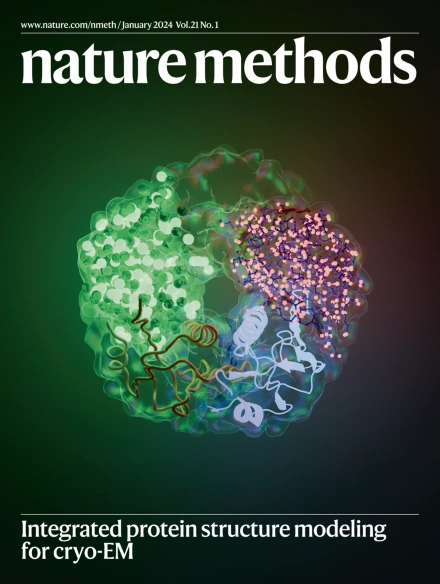MiLoPYP:自监督分子模式挖掘和粒子原位定位
IF 36.1
1区 生物学
Q1 BIOCHEMICAL RESEARCH METHODS
引用次数: 0
摘要
冷冻电层析成像技术能以纳米级分辨率对细胞的三维结构进行常规可视化。与单粒子层析成像技术相结合,可以获得在原生环境中经常出现的大分子的近原子分辨率结构。低温电子层析成像/单粒子层析成像技术面临的两大挑战是蛋白质的自动识别和定位,而细胞内的分子拥挤、低温电子层析成像层析图特有的成像失真以及层析成像数据集的庞大规模阻碍了这项任务的完成。目前的方法准确率低,需要大量耗时的人工标记,或仅限于检测特定类型的蛋白质。在这里,我们提出了 MiLoPYP,这是一种基于对比学习的两步式数据集特定框架,可实现快速的分子模式挖掘和精确的蛋白质定位。MiLoPYP 能够有效地检测和定位包括球状和管状复合物以及大型膜蛋白在内的多种目标,这将有助于简化和拓宽原位结构测定的高分辨率工作流程。本文章由计算机程序翻译,如有差异,请以英文原文为准。


MiLoPYP: self-supervised molecular pattern mining and particle localization in situ
Cryo-electron tomography allows the routine visualization of cellular landscapes in three dimensions at nanometer-range resolutions. When combined with single-particle tomography, it is possible to obtain near-atomic resolution structures of frequently occurring macromolecules within their native environment. Two outstanding challenges associated with cryo-electron tomography/single-particle tomography are the automatic identification and localization of proteins, tasks that are hindered by the molecular crowding inside cells, imaging distortions characteristic of cryo-electron tomography tomograms and the sheer size of tomographic datasets. Current methods suffer from low accuracy, demand extensive and time-consuming manual labeling or are limited to the detection of specific types of proteins. Here, we present MiLoPYP, a two-step dataset-specific contrastive learning-based framework that enables fast molecular pattern mining followed by accurate protein localization. MiLoPYP’s ability to effectively detect and localize a wide range of targets including globular and tubular complexes as well as large membrane proteins, will contribute to streamline and broaden the applicability of high-resolution workflows for in situ structure determination. MiLoPYP is a two-step, dataset-specific contrastive learning-based method for fast and accurate detection and localization of a diverse range of target structures in cryo-electron tomography data, enabling improved in situ structural biology.
求助全文
通过发布文献求助,成功后即可免费获取论文全文。
去求助
来源期刊

Nature Methods
生物-生化研究方法
CiteScore
58.70
自引率
1.70%
发文量
326
审稿时长
1 months
期刊介绍:
Nature Methods is a monthly journal that focuses on publishing innovative methods and substantial enhancements to fundamental life sciences research techniques. Geared towards a diverse, interdisciplinary readership of researchers in academia and industry engaged in laboratory work, the journal offers new tools for research and emphasizes the immediate practical significance of the featured work. It publishes primary research papers and reviews recent technical and methodological advancements, with a particular interest in primary methods papers relevant to the biological and biomedical sciences. This includes methods rooted in chemistry with practical applications for studying biological problems.
 求助内容:
求助内容: 应助结果提醒方式:
应助结果提醒方式:


